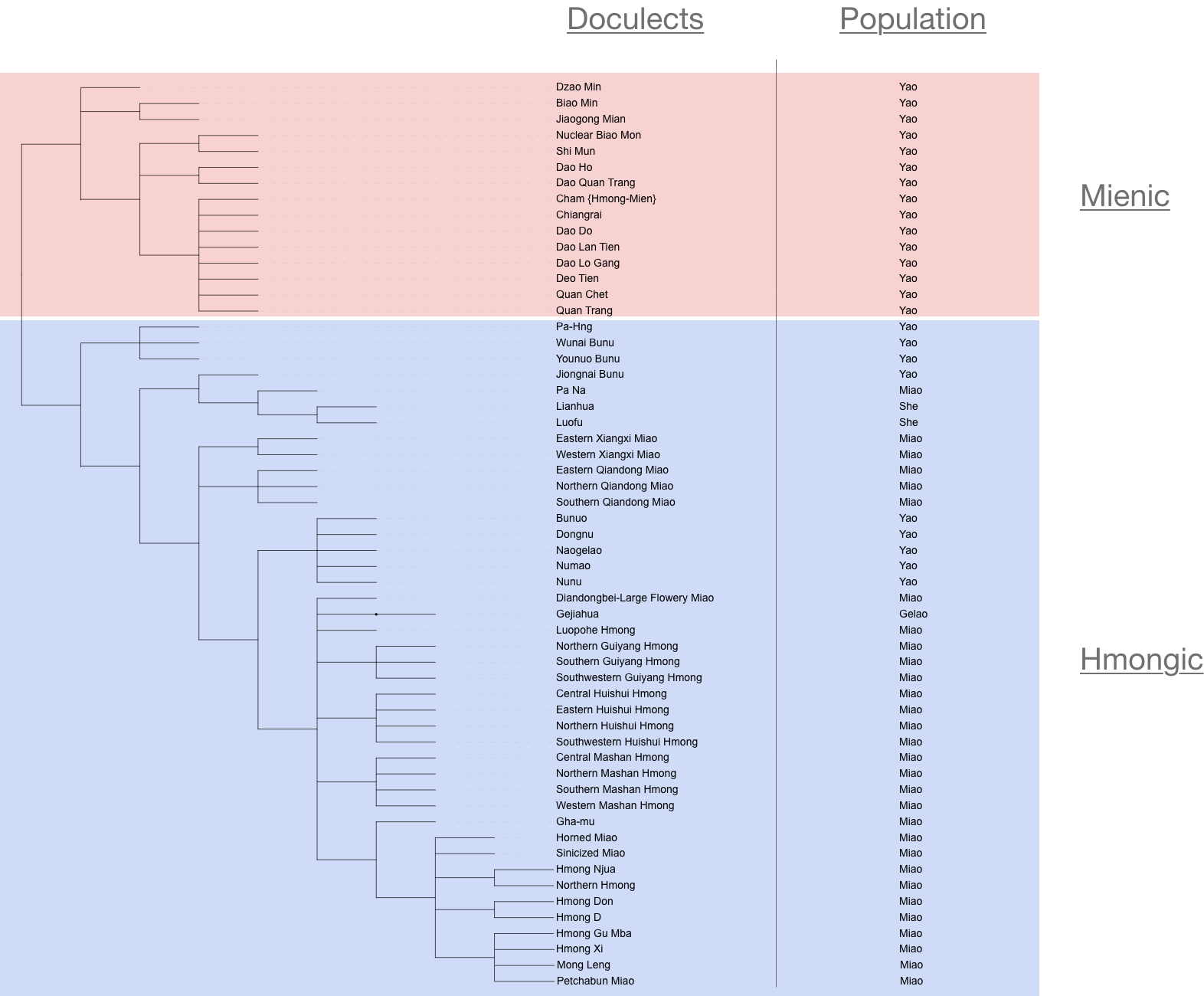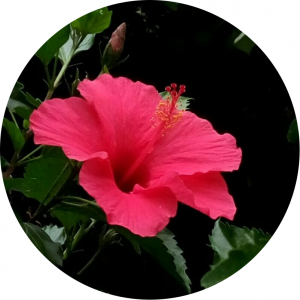苗族與瑤族是中國南部著名的少數民族, 多數苗寨與瑤寨分布於廣西與貴州。除此之外, 泰國北部, 越南, 寮國以及北美洲皆有苗族與瑤族族人定居。關於這兩個族群的發源地尚未可知, 但可從中國各朝代的經典史籍以及盤瑤¹特有的「過山榜」中粗略得知苗族與瑤族的遷徙史。
在Glottolog 上列有苗瑤兩族的語言一共有39個方言,與中國境內多數語言不同的特點是苗瑤語並不屬於漢藏語系²。許多中文的書籍與文章將此語系稱作苗瑤(Mieo-Yao)語系, 又名赫蒙-勉(Hmong-Mien)語系。但其實兩個語系名稱的根據並不一致, 苗瑤語系是直接將族群名稱當做語系名稱, 而赫蒙-勉語系是通過歷史語言學的比較方法而定名的。因此苗-瑤語系與赫蒙-勉語系是不等價的。
A total of 39 Miao and Yao varieties are listed on the Glottolog website under the category of the Hmong-Mien family instead of the Sino-Tibetan language family². Many Chinese books and articles refer the Hmong-Mien language family to the Miao-Yao language family. However, it is wrong to state that the Hmong-Mien language family is equal to the Miao-Yao language family. The label “Miao-Yao” is the combination of two autonyms, “Miao” and “Yao”, but the label “Hmong-Mien” is given based on the language branches “Hmongic” and “Mienic”. The two branches are categorized by applying the comparative method in historical linguistics.
本文章引用Glottolog上的譜系³以及所屬族群來說明此不等價關係。在語言學上分析使用田野調查收集到的語料(多數是詞彙)進而決定語言與語言之間的遠近關係。集合相近的語言成一個語支, 再由語支歸納出語群, 一層層的向上建構後可以發現赫蒙-勉語系是由赫蒙語群以及勉語群所構成的語系⁴。由圖中可以看出勉語群(粉色)是瑤族的語言, 然而說赫蒙語的族群包含苗、瑤、畬以及仡佬族。
The figure below illustrates the argument that the the label “Hmong-Mien” is much more appropriate than the label “Miao-Yao” to describe these languages/dialects. The categorization was taken from the Glottolog website³, and I annotated the speech communities next to the taxon. The clusters on Glottolog is a summary of several linguistic studies. The Hmong-Mien language family is comprised of two big clusters, namely, Hmongic and Mienic groups⁴. The group marked in pink is the Mienic group, and the speakers are Yao people. However, the speakers of Hmongic languages include Miao, Yao, She and Gelao populations.

雖然苗瑤語系以及赫蒙-勉語系所指的是同一個群體, 但是「苗-瑤語系」是直接使用兩大族群的族稱作為語系名稱, 並不是根據語言學的比較方法而歸納出的結論, 對於語系內部的親屬關係的描述不夠精準。不精準的劃分, 再加上多數文章粗粗略略的一句「苗-瑤語系又名赫蒙-勉語系」容易讓人產生「苗人說赫蒙語,瑤人說勉語」的錯誤認知。「赫蒙-勉語系」(Hmong-Mien)才是依據歷史語言學的分析方法而推論出較為適合描述此語係內部的分類。
From this figure, one can already see that the label “Miao-Yao” does not precisely describe the language family. Furthermore, “Miao-Yao” creates the misconception that “the Miao people speak the Hmongic languages, and that the Yao people speak the Mienic languages.”. Overall, the Hmong-Mien language family is a much more appropriate term than the Miao-Yao language family in the field of linguistic research.
Acknowledgement
Thanks to Dr. Lai, Yunfan for proofreading the article.
備註:
- 盤瑤是瑤族的一支。在此推薦一篇關於過山榜的研究文獻 Alberts, Eli 2016. 《過山榜》:帝國象徵的南疆操弄 . https://www.ncl.edu.tw/downloadfile2_297_426.html
- 早前的研究將苗瑤語劃入漢藏語系, 但近幾年的歷史語言學研究傾向於將苗語以及瑤語視作為一個獨立的語系。
- Glottolog上的譜系樹的基本架構是根據Martha Ratliff的分類而來, 詳細內容請參閱Ratliff, Martha S. 2010. Hmong-Mien Language History. (Pacific Linguistics, 613.) Canberra: Research School of Pacific and Asian Studies, Australian National University. xi+298pp. (Studies in Language Change 8).。
- 亦有學者提出三個語群:Hmong、Mien、She。
 Mei-Shin Wu.
Mei-Shin Wu. TDRP
TDRP